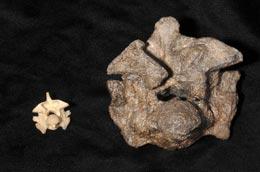Scientists find world's biggest snake

Jason Head of the University of Toronto and colleagues discovered 28 fossilized snake vertebrae and ribs in an open-pit coal mine at Cerrejón. The vertebrae's structure suggests the snake is closely related to the boa constrictor, leading the team to name the species Titanoboa cerrejonensis, or 'titanic boa from Cerrejon'. By comparing the shapes and sizes of the two best-preserved vertebrae to those of living snakes, the researchers calculated that the snake was 12.8 meters long and weighed 1,135 kilograms(Anaconda vertebrae left, Titanoboa vertebrae right) . Also interesting is the researchers can use the size of the animal to determine more about the climate and environment when this creature existed. They can determine what median temperature would support such a creature of that size and the theoretical amount of energy/resources to keep that creature alive.
Discovering monstrous fossils is always a fascinating occurrence. They reveal a time before we can imagine, where things were built much bigger and much stronger. However, despite these powerful attributes, the fossils also help support the belief in natural selection and survival of the fittest; extinct animals show us failed fitness. This titanic boa is just one of hundreds of examples where natural selection took place, forcing species' ancestors to adapt or become fossils themselves.
-Conor Stenerson(3)

11 Comments:
Conor,
This was a great blog! I was conversing with some students today in who are in a Herpetology class, and apparently we have huge snakes in Morrill. I had no idea. But this fossil discovery sure does support natural selection. I’m wondering if now, with “global warming,” the size of snakes will increase dramatically. They must be sensitive to environment changes, but how sensitive?
-Sarah Bello
Cool! You made a really good point about extinct animals being models of failed fitness. At this point in time, a 1,135 kg snake seems ridiculous. I'm really curious about the energy/resources part.
(Jane de Verges)
I'm not kidding when I say my knees are wobbling. I couldn't even look at the link for fear there may be pictures of what they thought it looked like. I HATE them, and I hate that i just read in a previous comment that there are some in Morrill. I may or may not go to class ever again. All I can say is thank god I was not alive when snakes were almost 13 meters long. They only need to be the size of worms for me to hate them. Still an interesting topic. Sorry for my strong opinion if your a snake lover.
-Emily Bell
I actually saw an article on this while stumbling but I wasn't sure if it was real or not at first. How big of animals was it eating? Maybe a better question is, what kind of animal was it eating. It would have to be something big enough to sustain a beast like that.
-Nick Cline
Conor,
From what I have read so far, most of the blogs deal with the concept of “natural selection.” However, wouldn’t the enormous size of the Titanoboa Cerrejonensis be a predominate trait to have, especially taking in to account the predator-prey food pyramid? Small snakes are a big part of the diets for hawks, vultures, and owls. So, would it not make sense that the larger snakes, which were better equipped for survival than the smaller snakes, passed on their traits for the next generation to adapt.
Saad Choudhry
This is really neat, do they know when this titanic boa from Cerrejon dates back to yet? Were they to big to escape larger predators that existed in their time or possibly was there not enough food to sustain such a large sized snake?
Samantha DeBiasio
Natural selection is a large impact on evolution. I wonder why the snakes evolved into a smaller species despite the advantages of a larger size and rib cage. Due to the fact that most dinosaurs are extinct, I feel that perhaps the smaller size was the one to prevail.
Rachael Carlevale
Wow thats gigantic! I can't even imagine a snake that big, were all the 28 fossils that large? I read an article that said a T-rex was about 12 meters long and this snake is 12.8m It is so crazy that it is on the same size scale as a dinosaur. Do you know how many millions of years ago this was? I feel like this snake could have been big enough to live around the same time as dinosaurs.
-Willow Alves
How scary would that be. Humans would have a predator. Creepy. Also, the snake would have no predators...or would it? what was the time frame of this creature? I would be interested to find out about any predators it could have had at that time period.
Emily Ayotte
Having a snake thats greater than 1,135 kg and 12.8 meters long is never heard of. It clearly shows that snake florished during the Palaeocene period when dinosaurs have vanished and small mammals were developing. With plenty of weak mammals the titanic boa from Cerrejon could easily reap in prey. It would be interesting to know how old it was when it became fossilized. Since snakes molt in order to grow there's a time when they become weak, but does it actually have any predators?
-Peter Lau
Wow. Do they know the era or timeframe of when it lived? I guess when we consider 100m tall mosses and huge insects that existed back in the jurassic and whatnot, it makes sense that we should see 1-ton snakes.
[Nathan Beck]
Post a Comment
<< Home